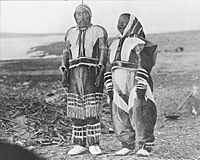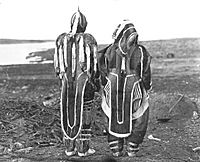Copper Inuit facts for kids
| Total population | |
|---|---|
| 800 | |
| Regions with significant populations | |
| Northwest Territories; Nunavut |
|
| Languages | |
| Inuvialuktun (sometimes called Western Canadian Inuktitut; also referred to as Inuinnaqtun) |
|
| Religion | |
| Animism; Inuit religion |
The Copper Inuit, also known as Kitlinermiut and Inuinnait, are a group of Inuit people in Canada. They live north of the tree line in areas like the Kitikmeot Region of Nunavut and the Inuvik Region of the Northwest Territories. Historically, most of them lived around Coronation Gulf, on Victoria Island, and southern Banks Island.
The name "Copper Inuit" comes from their use of native copper. They gathered this metal along the lower Coppermine River and the Coronation Gulf. They used it to make tools and weapons. Other Inuit groups sometimes called them Kitlinermiut, because Kitlineq was an Inuit language name for Victoria Island.
Contents
A Look Back in Time
Early History
Like all Inuit, the Copper Inuit are descendants of the Thule people. Changes in their environment likely led to their unique culture developing from the older Thule ways.
For about 3,000 years, the Copper Inuit were hunter-gatherer nomads. This means they moved around to find food. They have only recently started living in permanent settlements, mostly since the 1940s. However, many still continue their traditional hunting and gathering lifestyle.
In winter, they lived in shared snowhouses and hunted seals. In summer, they split into smaller family groups to hunt caribou inland and to fish.
The Copper Inuit were skilled at making tools from copper. They created copper arrows, spear heads, ulu blades, chisels, harpoons, and knives. They used these for themselves and traded them with other Inuit groups. Their soapstone products were also highly valued in trade networks.
Contact with Europeans
Stories from the Inuit show that there were often conflicts between the Inuit and the Dene people. These conflicts might have been about trade or sometimes about raiding for women. One famous event was recorded by the explorer Samuel Hearne in 1771. His Dene guides had a conflict with a Copper Inuit group at Bloody Falls.
More European explorers came to the area between 1820 and 1853, including John Franklin and John Rae. In 1853, explorer Robert McClure left his ship, HMS Investigator, at Mercy Bay on Banks Island. The Copper Inuit used the wood, copper, and iron from this abandoned ship for many years.
The 20th Century
In the early 1900s, trading ships began to visit the Copper Inuit territory. This happened after explorer Vilhjalmur Stefansson met and reported on the Copper Inuit. From 1913 to 1916, Canadian ethnographer Diamond Jenness lived with the Copper Inuit for two years. He studied and wrote about their lives, sending many of their tools and items to the Geological Survey of Canada.
When Europeans arrived, they brought new diseases like influenza and typhoid. These diseases made many Copper Inuit sick. Between 1929 and 1931, a tuberculosis outbreak caused many deaths. Around this time, the whaling industry also declined.
Modern Settlements
In 1960, the Canadian government sent houses to Holman (now called Ulukhaktok). More houses followed in 1961. Over time, some families moved to Holman permanently, while others lived there part-time. Some Copper Inuit also moved to communities like Coppermine (Kugluktuk) or Cambridge Bay.
Today, the Copper Inuit have adopted many modern things like snowmobiles, satellite TV, and Christian churches. Many young people now speak English instead of Inuinnaqtun. These changes have brought new ways of life to the Copper Inuit.
Culture and Daily Life
Language
The Copper Inuit traditionally speak Inuinnaqtun and Inuvialuktun. These languages are sometimes called Western Canadian Inuktitut.
What They Ate
Historically, the Copper Inuit lived in areas with tundra, rocky hills, and some forests. They hunted animals like Arctic ground squirrels, Arctic hares, caribou, grizzly bears, muskoxen, polar bears, and wolfs.
They also fished in the many ponds, lakes, and rivers, catching Arctic char, grayling, lake trout, and whitefish. The ocean provided codfish, bearded seals, and ringed seals. Birds like ducks, geese, and ptarmigans were also part of their diet. They liked to eat raw eggs but not boiled ones. They kept food and products from the sea separate from those of the land.
Their Clothes
Copper Inuit clothing was designed for the cold Arctic. They wore short inner parkas with long, narrow tails at the back. For very cold weather, they added a heavy outer parka. Women's parkas had longer hoods and pointed shoulders. Their boots went up to the waist and had soles made from feathers or bird skins. They even used different napkins for different meals: ptarmigan skins for caribou and gull skins for seal.
Today, their clothing and boots are made from various animal skins, including caribou, beaver, polar bear, and seal.
In the past, many Inuit also had special ceremonial clothing made from summer skins. These were worn for dancing or other special events. The designs on these clothes often showed the connection between humans, animals, and the spirit world. By the 1930s, this ceremonial clothing was no longer used, but it was brought back in the 1990s.
Their Beliefs
The Copper Inuit had an animistic spiritual system. This means they believed that spirits were present in animals and nature. They thought that if certain rules (taboos) were broken, animal spirits could become upset. They also believed in different beings like dwarfs, giants, "caribou people," and a sea-goddess named Arnapkapfaaluk. Their idea of the tupilaq was similar to the Christian idea of the devil.
Their spiritual leaders were called angakkuit (shamans), and they could be male or female. Shamans helped protect people from evil spirits, communicated with the spirit world, healed illnesses, and even tried to control the weather.
Notable Copper Inuit
- Joe Allen Evyagotailak
- Donald Havioyak
- Helen Kalvak
- Helen Maksagak
- Kane Tologanak
- Uloqsaq (historical)





